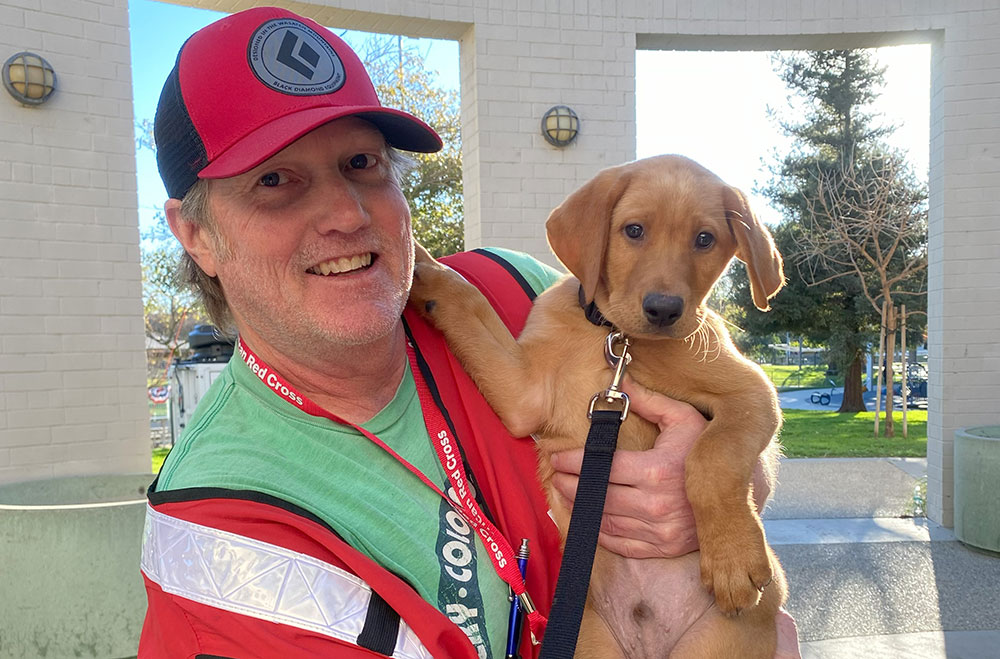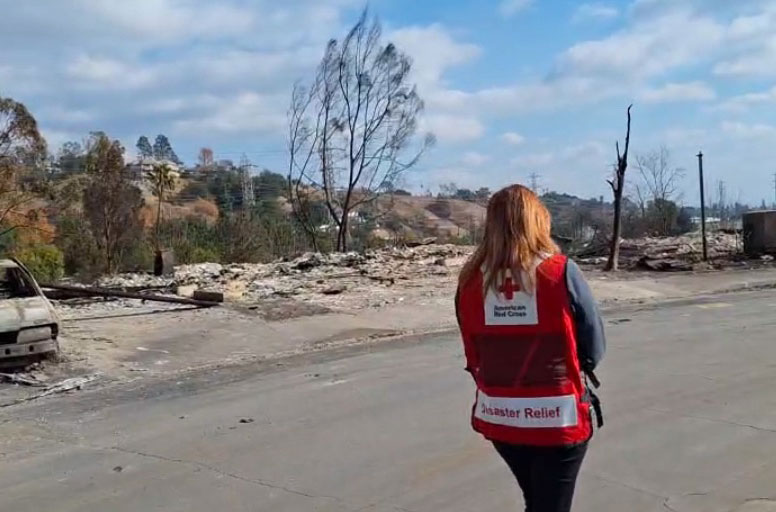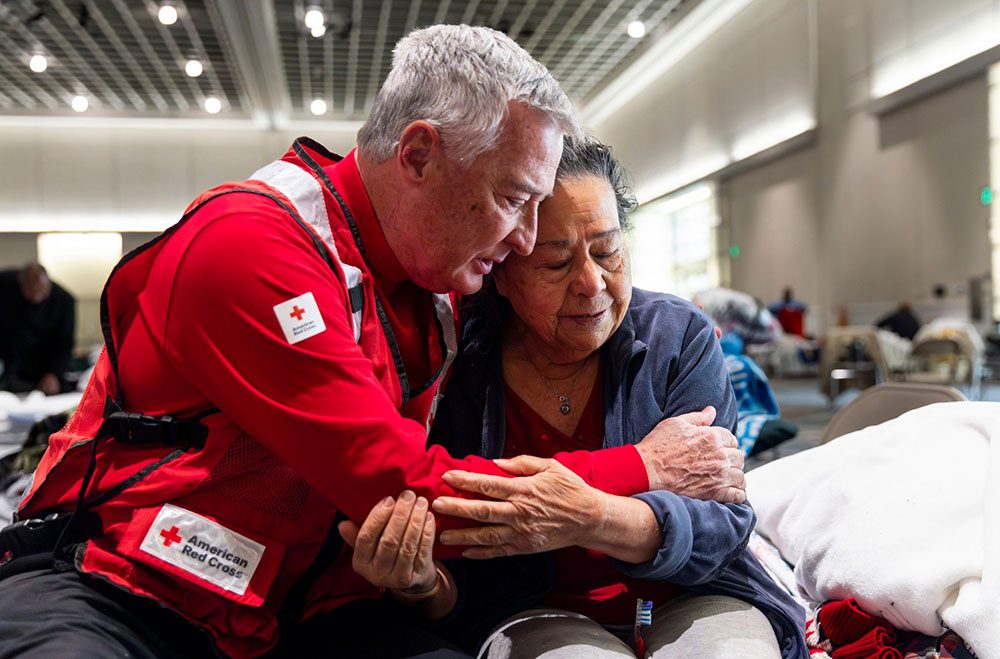by Emma Needell, American Red Cross
As January ended, two massive wildfires had torn through Southern California, destroying more than 16,000 structures and displacing thousands. The American Red Cross launched a large-scale disaster relief operation, mobilizing more than 520 trained responders alongside local community members.
When Brian Drennan, a Red Cross volunteer from the Colorado-Wyoming region, first arrived at the Westwood Recreation Center, there were no neat rows of cots, no sign-in protocol or fixed mealtimes. “You don’t show up and it’s all set up perfectly,” Brian said. “You build it as you go.”
Overnight, the Westwood Recreation Center had been repurposed, its gymnasium cleared of basketballs and swim schedules to make space for what would soon become one of the most visible Red Cross shelters in Los Angeles. Within days, American Red Cross volunteers transformed it into something steady: rows of cots, stations for meals and medical care, tables where caseworkers and mental health teams listened.
Brian didn’t plan to become feeding supervisor at the Westwood shelter. But by day two, someone needed to step in. “You sort of ‘get promoted’ in the field if it’s needed,” he said. He became responsible for breakfast—coordinating coffee, croissants, fruit, and donated pastries.
“I had a ton of community members come out of the woodwork… bagels, bakeries, wanted to donate,” he said. One morning, “a woman from a bakery showed up with 500 pastries.”
By day five, a rhythm had emerged. What began as an improvisation became something like a system. “It was a controllable process,” Brian said. “It grew so fast, into this little village.”
As the fires continued to rage, more volunteers, including many from Colorado and Wyoming, arrived, not to save the day, but to join a long chain of care. They provided food, shelter, emotional care, and support for households inside the fire perimeters of the Eaton, Palisades, Hurst, and Kenneth fires.
In Los Angeles, they stepped into shelters already buzzing with tension and need, bringing with them not just experience but steadiness, humility, and a readiness to serve alongside others from every corner of the map.

Volunteer Brian Drennan and one of the many pets also affected by the fires.
Stacey Pottish deployed to Los Angeles from her post as Community Disaster Program Manager for the Mile High Chapter in Denver, Colorado. It was her first national deployment.
“I witnessed pain, destruction, and heartbreak,” she said. “I also witnessed incredible resilience—people coming together, supporting one another, and finding strength in their shared struggle.”
Stacey’s team focused on community engagement and partnerships. “First, we managed an overwhelming response from community partners eager to help—our job was to assess their offerings, vet them, and organize the information for public distribution,” Stacey explained “Second, we identified gaps in the community’s needs and worked to find solutions. Lastly, we ensured that affected residents were aware of the services the Red Cross provided, including financial assistance.”
One moment remains etched: a woman walking through the wreckage of her home of over 30 years, describing each room as it once was. “Even though she was sad, she expressed gratitude that her son had rescued her from the fire,” Stacey said. “She was thankful to be alive and spoke with determination about rebuilding her life.”

Red Crosser Stacey Pottish assesses the fire damage.
Kim Mailes has deployed to disaster relief operations across the country—from floods in Iowa to hurricanes in Florida, a typhoon in Guam, and wildfires in Hawaii. “I’ve lost track of the deployments,” he said. In 2024 alone, he responded to ten separate relief efforts.
Kim began volunteering with the Red Cross after selling his business. “I had the rare opportunity to choose who I was going to be for the rest of my life,” Kim said. “The Red Cross provided the perfect opportunity to use my talents in a way I find really fulfilling, and at the same time make a difference in the lives of others, particularly in those dark days immediately following a disaster.”
In Los Angeles, Kim served first as a story producer for the national photography team, then returned for a second deployment as Assistant Director for External Communications. “This deployment has been a two-part episode for me,” he said. “It’s been a rewarding learning experience to gain experience in the operational side of disaster relief.”
But the story that stayed with him wasn’t logistical. It was human.
“I spoke with a wonderful 101-year-old woman in one of the Red Cross shelters,” he recalled. “She fled her home as wildfires raced through her neighborhood, sought lodging in several hotels only to find no rooms available, and was directed by police to the shelter.”
“She left me with a wonderful memory—taking my hand and gripping it firmly in both of hers, she said, ‘Thank you, Red Cross for all you are doing. I don’t know what I would have done without you.’”

Volunteer Kim Mailes comforts a resident at the Red Cross shelter.
There is no typical Red Cross volunteer. Brian works in film and TV. Stacey manages disaster programs. Kim built a business and now builds teams. Some volunteers are retired. Some take time off work. Some bring technical expertise. Some bring kindness, or calm, or the ability to listen.
And that’s the point. To show up in times of need to provide support and ask, What do you need? How can we help?
If you would like to volunteer like Brian, Stacey, and Kim and provide support for those affected by disaster, visit redcross.org/volunteer to get started today.
Support all the urgent humanitarian needs of the American Red Cross.
Find a drive and schedule a blood donation appointment today.
Your time and talent can make a real difference in people’s lives. Discover the role that's right for you and join us today!